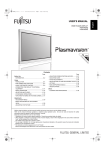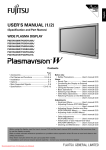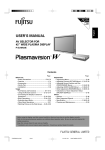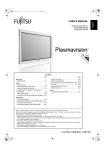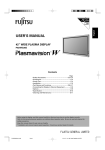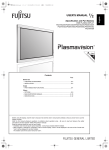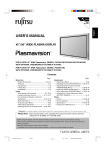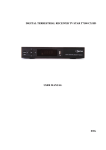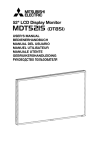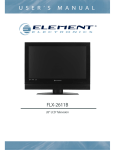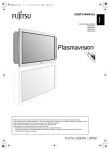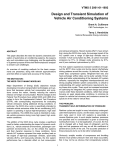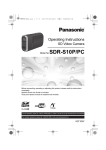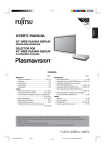Download USER`S MANUAL - fujitsu general
Transcript
1 ページ 2005年6月14日 火曜日 午前11時50分 USER’S MANUAL English MHD01862_E.book Italiano Français Español AV SELECTOR FOR WIDE PLASMA DISPLAY P-TU4240G / P-TU5040G Deutsch WIDE PLASMA DISPLAY P42HTS40G / P50XTS40G • INFORMATION ............................................................ E-2 • INSTALLATION............................................................ E-4 Usage Page • OTHER ADJUSTMENTS ...........................................E-38 • INITIALIZATION OF USER ADJUSTMENT VALUE ..E-44 Others • OPTIONS ...................................................................E-45 • PART NAMES AND FUNCTIONS ............................... E-5 • MAIN SUPPORTED SIGNALS...................................E-46 • USING THE REMOTE CONTROL............................. E-12 • TABLE OF TV FREQUENCIES..................................E-47 • CONNECTING THE DISPLAY TO EXTERNAL • SPECIFICATION ........................................................E-48 EQUIPMENT .............................................................. E-14 • CLEANING AND MAINTENANCE .............................E-50 • BASIC OPERATIONS ................................................ E-24 • SELECTING INPUT MODE ....................................... E-26 Póññêèé Page Before Use Português Contents • OTHER BASIC OPERATIONS .................................. E-29 • WATCHING PICTURES ON THE WIDE SCREEN.... E-30 Adjustments • ADJUSTMENT MENU................................................ E-32 • BASIC PROCEDURE OF ADJUSTMENT MENU OPERATIONS............................................................ E-33 • ADJUSTING THE PICTURE ...................................... E-34 • ADJUSTING SCREEN POSITION AND SIZE ........... E-36 日本語 Before using the display, read this manual carefully so that you know how to use the display correctly. Refer to this manual whenever questions or problems about operation arise. Be sure to read and observe the safety precautions (see the separate "Safety Precautions" manual). Keep this manual where the user can see it easily. * Installation and removal require special expertise. Consult your product dealer for details. * When "English" is selected at "Language" of the on-screen display, "colour" will be displayed but "color" is described in this manual. * The last digit of MODEL NO. (10 digit alphanumeric characters) indicated on the product means the body color indication alphabet or the management number. 中文 • ADJUSTING AUDIO................................................... E-37 MHD01862_E.book 2 ページ 2005年6月14日 火曜日 午前11時50分 INFORMATION • Receptacle Make sure that the power cable’s grounding wire is grounded. The display comes with a 3-prong power plug; one prong is connected to the grounding wire. If you have only a 2-hole receptacle, you will need to have it replaced. Contact your dealer for more information. • Have the display inspected and cleaned by your dealer at regular intervals. • Pictures may become “burnt” into the screen phosphors if the screen is left on for extended periods. To ensure that the display has a prolonged service life, be sure to use a screen orbiter, white screen. This will ensure the same picture or pattern is not constantly displayed for long periods. (See P. E-42.) • Extremely high-precision technology has been used in the manufacture of the plasma display panel, with the effective pixel elements exceeding 99.99%. Please be aware, however, that fewer than 0.01% of the pixels may be missing or remain constantly lit. • Some models are fitted with a radiator fan to prevent the display’s internal temperature from rising during operation. Be careful of the air emitted by the radiator fan, as it may be hot. • Contact your dealer if you find that the display does not seem to function properly when used with other audio-visual equipment. You may need to move your display if it produces degraded pictures or noise due to electromagnetic radiation, or if the infrared remote control does not function properly. • Pictures may not be displayed properly if you connect a non-standard PC to the RGB input terminal. In this case, contact your dealer for more information. • The protective circuit, built into the display, automatically turns off the power if the display has a problem. In this case, you will see that the power indicator lamp flashes red or green. Warning If the power indicator lamp flashes red or green, this signifies that the display has developed a problem. When this happens, be sure to remove the power plug from the receptacle to prevent fire or electric shock. Then contact your dealer. • Install the display in a location close to a main power supply outlet, and where the emergency stop button can be easily reached. Note • Cables for connecting the display to external equipment are not supplied. Contact your dealer for more information on these products. • In order to facilitate the explanations, pictures and diagrams in this manual may differ slightly from the actual items. E-2 3 ページ 2005年6月14日 火曜日 午前11時50分 English MHD01862_E.book Deutsch CHECKING ACCESSORIES One power cable One System cable (picture) One System cable (audio) Two small ferrite cores One big ferrite core No.:ZCAT1518-0730 Mfr.:TDK No.:SFT-72SN Mfr.:TKK Español Display Section Two user's manuals Two AA batteries One power cable Manual Italiano Manual One remote control Français AV Selector Section Português One big ferrite core 日本語 中文 Póññêèé No.:SFT-72SN Mfr.:TKK E-3 MHD01862_E.book 4 ページ 2005年6月14日 火曜日 午前11時50分 INSTALLATION To prevent the display's internal components from overheating, make sure that the display is installed in a well-ventilated location. Be sure to use the optional stand, wall-mounting unit or the other unit when installing the display. Also, be also sure that your dealer performs the installation. See the appropriate instruction manual for more information on the installation hardware you select. To prevent an accident and ensure safety in the event of an earthquake, fix the display securely into position as described below. To ensure proper heat radiation, provide at least as much space around the display as shown below. * Make sure that the display is installed in a location where the temperature can be maintained between 0°C and 40°C. * Never attempt to tilt the display sideways or backward. * To prevent the power and other cables from being accidentally pulled, make sure that they run along the wall or through corners. * To prevent accidents and ensure safety in the event of an earthquake, secure the display to prevent it from tipping over. Display Section Front Side (cm) (cm) Upper 10 Left 10 10 Wall Right 5 Lower 3.5 AV Selector section Front Side (cm) (cm) Upper Upper Rear Left Right Floor Floor Note The display is a highly precise piece of equipment and therefore must be packed properly before transportation. Be sure to use only those packing materials originally supplied with the display when repacking it. Reference See P. E-45 for more information on options. E-4 MHD01862_E.book 5 ページ 2005年6月14日 火曜日 午前11時50分 English PART NAMES AND FUNCTIONS Power indicator lamp This lamp shows the state of the power supply. Lit (red): Stand-by state Lit (green): Power ON state Flashing (red or green): Malfunction (Flashes differently depending on the type of malfunction.) Español (Right section) Deutsch DISPLAY SECTION – FRONT Remote control signal receiver Input mode selector button [MODE] Input mode selector button [MODE] Français Receives signals from the remote control. Switches between picture input modes. VOL + button Italiano VOL - button Adjusts the audio volume. Wide screen selector button [WIDE] Switches the screen over to a desired wide screen. Português ON/OFF button Turns the power "ON" and "OFF (standby state)". Ambient Sensor 日本語 中文 Póññêèé Detects the brightness of external light. Do not obstruct it. Warning If the power indicator lamp flashes red or green, this signifies that the display has developed a problem. When this happens, be sure to remove the power plug from the receptacle and contact your dealer. Leaving the display power ON can result in fire or electric shock. E-5 MHD01862_E.book 6 ページ 2005年6月14日 火曜日 午前11時50分 PART NAMES AND FUNCTIONS (Continued) DISPLAY SECTION – LOWER PART /l power switch If this button is pressed when the power indicator lamp is off, the indicator lamp will light. The power can be turned on and the standby mode selected by using the remote control or the control panel of the display. If this button is pressed when the power indicator lamp is lit, the indicator lamp will go out. *Power is still supplied to parts of the display even if the indicator lamp is off. Display input (picture) terminal Connect this terminal to the display output (picture) terminal on the AV Selector using the special cable provided. Display input (audio) terminal Connect this terminal to the display output (audio) terminal on the AV Selector using the special cable provided. External speaker output terminal (EXT SP) Connect this terminal to the optionally available speaker. When connecting a cable, attach a ferrite core to the cable. (See P. E-14.) *See the speaker user’s manual for more information. Power input terminal Connect this terminal to the power cable supplied with the display. When connecting a cable, attach a ferrite core to the cable. (See P. E-14.) E-6 7 ページ 2005年6月14日 火曜日 午前11時50分 English MHD01862_E.book Français Español Deutsch AV SELECTOR SECTION – FRONT Power indicator lamp Lit (red): Stand-by Lit (green): Power ON Italiano This lamp shows the state of the power supply. Flashing (red or green): Malfunction (Flashes differently depending on the type of malfunction.) Português Remote control signal receiver Receives signals from the remote control. /l power switch If this button is pressed when the power indicator lamp is off, the indicator lamp will light. The power can be turned on and the standby mode selected by using the remote control or the control panel of the display. Póññêèé If this button is pressed when the power indicator lamp is lit, the indicator lamp will go out. *Power is still supplied to parts even if the indicator lamp is off. Video3, S-video input terminal * Connect this terminal to the S-video output terminal of your video camera, etc. Video3, video input terminal * Connect this terminal to the video output terminal of your video camera, etc. Audio input terminals (L/R) These are the audio input terminals for the Video3 and RGB3 terminals. Input the audio for the video to be seen here. RGB3 input terminal 中文 Connect this terminal to your PC's mD-sub output terminal. * On selecting the video input format 日本語 (See "SETTING THE INPUT TERMINALS" on P. E-40.) Warning If the power indicator lamp flashes red or green, this signifies that the display has developed a problem. When this happens, be sure to remove the power plug from the receptacle and contact your dealer. Leaving the display power ON can result in fire or electric shock. E-7 MHD01862_E.book 8 ページ 2005年6月14日 火曜日 午前11時50分 PART NAMES AND FUNCTIONS (Continued) AV SELECTOR SECTION – REAR ӽ Audio input terminals Input audio through the terminals corresponding to the used video input terminals. * The digital input terminals can be matched as desired with the remote control. (See P. E-29.) Audio output terminals For use when the audio from an audio system (amplifier) is used. Video1 input terminal Video2 input terminal Video4 input terminal Connect this terminal to the SCART terminal of your VCR or DVD, etc. * See "SETTING THE INPUT TERMINALS" on P. E-40. Video5 input terminal Video6 input terminal Connect this terminal to the component video output terminal of your DVD, etc. Video7 input terminal Connect this terminal to the HDMI output terminal of your DVD, etc. RGB1 input terminal Connect this terminal to the monitor (DVI-D) output terminal of your PC. RGB2 input terminal Connect this terminal to the monitor (mD-sub) output terminal of your PC. Display output terminals (Picture/Audio) Connect these terminals to the picture input terminal and audio input terminals on the display. Power input terminal Connect this terminal to the power cable supplied with the display. When connecting a cable, attach a ferrite core to the cable. (See P. E-14.) Antenna input terminal Please connect it to the antenna signal. E-8 9 ページ 2005年6月14日 火曜日 午前11時50分 English MHD01862_E.book 20 1816 1412 10 8 6 4 2 21 17 13 9 5 1 19 15 11 7 3 HDMI input terminal (VIDEO7) Signal T.M.D.S. Data2– 9 T.M.D.S. Data1– 17 T.M.D.S. Data0– 2 T.M.D.S. Data2+ 10 T.M.D.S. Data1+ 18 T.M.D.S. Data0+ 3 T.M.D.S. Data2 Shield 11 T.M.D.S. Data1 Shield 19 T.M.D.S. Data0 Shield 4 — 12 — 20 — 5 — 13 — 21 — 6 DDC Clock 14 +5V Power 22 T.M.D.S. Clock Shield 7 DDC Data 15 Ground (for +5V) 23 T.M.D.S. Clock+ 8 — 16 Hot Ploug Detect 24 T.M.D.S. Clock– Pin No. Input signal Pin No. 9 Español 1 Input signal 1 Red 2 Green 10 Ground 3 Blue 11 — 4 — 12 — 5 Ground 13 Horizontal synchronization 6 Ground 14 Vertical synchronization 7 Ground 15 — 8 Ground Frame Ground Pin No. Input Signal Pin No. Input Signal — Pin No. Input Signal 1 — 8 — 15 Red/chrominance 2 Right audio 9 Green ground 16 — 3 — 10 — 17 — 4 Audio ground 11 Green 18 Composite video ground 5 Blue ground 12 — 19 — 6 Left audio 13 Red ground 20 Composite video/Y 7 Blue 14 — 21 Ground Pin No. Input signal Pin No. Français Pin No. Italiano Signal Português SCART terminal (Video1, 2, 4) Pin No. Input signal 1 T.M.D.S. Data2+ 11 T.M.D.S. Clock Shield 2 T.M.D.S. Data2 Shield 12 T.M.D.S. Clock– 3 T.M.D.S. Data2– 13 CEC 4 T.M.D.S. Data1+ 14 Reserve 5 T.M.D.S. Data1 Shield 15 DDC Clock 6 T.M.D.S. Data1– 16 DDC Data 7 T.M.D.S. Data0+ 17 Ground (for +5V) 8 T.M.D.S. Data0 Shield 18 +5V Power 9 T.M.D.S. Data0– 19 Hot Plug Detect 10 T.M.D.S. Clock+ Frame FG 中文 mD-sub input terminal (RGB2, 3 INPUT/mD-sub) Signal Póññêèé Pin No. 日本語 DVI-D terminal (RGB1 INPUT/DVI-D) Deutsch DESCRIPTION OF INPUT TERMINALS HDMI, the HDMI logo and High-Definition Multimedia interface are trademarks or registered trademarks of HDMI Licensing LCC. E-9 MHD01862_E.book 10 ページ 2005年6月14日 火曜日 午前11時50分 PART NAMES AND FUNCTIONS (Continued) REMOTE CONTROL For details, see page Î. button Î E-24 Switches between Power On and Standby. (STILL button) Î E-29 Displays the screen being watched as the still picture. To return to normal, press this button once again. (WIDE button) Î E-30 Switches the screen size. (TV input mode selector button) Î E-26 Press this button to watch terrestrial broadcastings. (Video input mode selector button) Î E-28 Press this button to switch through VIDEO1 to VIDEO7. (RGB input mode selector button) Î E-28 Press this button to switch through RGB1 to RGB3. (TELETEXT input mode selector button) Î E-27 Press this button to switch to the teletext broadcastings. (selectable only when watching the TV.) – (Number buttons) Î E-26 Use these buttons for the Program No. selection directly. In the teletext broadcastings, input the 3 digits for the required teletext page to change the page. (Channel Up/Down buttons) Î E-26 Press these buttons to select the preset programs. Use these buttons to scroll through a page in the teletext broadcasting. (Volume adjustment buttons) Î E-25 Press these buttons to adjust the volume. (AUDIO IN button) Î E-29 Press this button to select the audio input. (Channel Return button) Î E-26 Returns to the previous Program No. and input mode immediately. (Menu button) Î E-32–E-44 Press this button to display the menu screen for adjusting the picture and/or the audio. (MUTE button) Î E-25 Temporarily mutes the audio. To return the audio to normal, press this button once again, or press the work also. (Adjustment buttons) Î E-32–E-44 does the Use these buttons to select the item or adjust the value in the Menu screen. Use these buttons to scroll through the pages and switch among the LIST pages in the teletext broadcasting. (Only are used when switching LIST pages.) E-10 11 ページ 2005年6月14日 火曜日 午前11時50分 English MHD01862_E.book Press this button to fix the entry in the ADJUSTMENT MENU. (DUAL/STEREO button) Î E-29 Press this button to select the audio mode for stereo/dual-channel audio broadcasting. (COLOR button) Î E-27 In the teletext broadcasting, press these buttons to switch through the pages stored to each of the four colors in the LIST mode. Other than the LIST mode, these buttons can also be used for the colored option selected from the four teletext new options displayed at the bottom of the screen. (SUBPAGE button) Deutsch (Enter button) Î E-32–E-44 Español (REVEAL button) Press this button to display hidden text (such as the answers to quizzes ,etc.). (HOLD button) Press this button to hold the transmission of the teletext program you are currently watching. (SIZE button) Italiano Press this button to change the size of the current watching page. (INDEX button) Press this button to return to the INDEX page. (MODE button) Switches to the LIST mode. Press this button once again to return to the current mode. (STORE button) Î E-27 In LIST mode, saves the current display to the Favorites page. (CANCEL button) Press this button to watch the terrestrial broadcasting you were watching before you pressed . Press it once again to return to the teletext broadcasting. (DISPLAY button) Î E-29 Press this button to display the Program No., input mode, and screen size status. The status is displayed for about five seconds. Português Póññêèé Français Press this button to display the SUBPAGE. (PICTURE MODE button) Î E-29 Use this button to switch the Picture Mode. (OFF-TIMER) Î E-29 Use this button to specify the length of time until the power turns off (stand-by state) after the button is pressed. (PICTURE MEMORY button) Î E-29 日本語 中文 Press this button to access the Picture Memory. Note • Functions may not be available with some models and some device options. E-11 MHD01862_E.book 12 ページ 2005年6月14日 火曜日 午前11時50分 USING THE REMOTE CONTROL PUTTING BATTERIES IN THE REMOTE CONTROL (1) To remove the cover, slide it outwards while pressing it down. (2) Place two AA batteries in the remote control. Make sure that the batteries are properly oriented. (3) Close the cover until it snaps into place. PRECAUTIONS To prevent malfunction, be sure not to apply any form of severe shock to the remote control. To prevent malfunction or deformation, be sure not to allow the remote control to become wet; also, keep it away from hot locations or heating equipment. Be sure not to clean the remote control using a cloth dampened in any volatile solvent, such as benzene or thinner. CAUTION Be sure to use replacement batteries of the same type as the original ones. When disposing of used batteries, please comply with governmental regulations or environmental public institution’s rules that apply in your country/ area. Note The remote control will not function properly if the batteries are dead. Be sure to replace them as needed. Do not use rechargeable batteries (Ni-Cd, etc). E-12 13 ページ 2005年6月14日 火曜日 午前11時50分 English MHD01862_E.book Deutsch EFFECTIVE RANGE FOR THE REMOTE CONTROL Point the remote control at the display’s signal receiver when using it. Left Français Español Make sure that there are no obstacles between the remote control and the display’s signal receiver. Right 5 m (Front) Left Italiano Right Português 5 m (Front) Póññêèé Display – front Upper Upper Lower Lower Note The remote control may not function properly if you use a high-frequency fluorescent lamp. If you experience problems, move the lamp or use the remote control from a different position. E-13 日本語 中文 Display – side MHD01862_E.book 14 ページ 2005年6月14日 火曜日 午前11時50分 CONNECTING THE DISPLAY TO EXTERNAL EQUIPMENT Be sure to turn OFF the power to the display and external equipment before making any connections. No cables are supplied with the display for connection to external equipment. The type of cable to be used varies depending on the PC model. Contact your dealer for more information. Carefully check the terminals for position and type before making any connections. Loose connectors can result in picture or color problems. Make sure that all connectors are securely inserted into their terminals. These ferrite cores are used to attenuate undesired signals. Attach them correctly as shown in the following illustrations. Two big ferrite cores (For Display and AV SELECTOR) When connecting a cable to the power input terminal attach one of these ferrite cores to the cable near the terminal. Power Cable Ferrite Core Two small ferrite cores When connecting a cable to the external speaker output terminal, attach a ferrite core to the cable near the terminal as illustrated on the right. E-14 15 ページ 2005年6月14日 火曜日 午前11時50分 English MHD01862_E.book Deutsch BASIC SYSTEM CONNECTIONS Speaker (optional) Italiano Français Display Español Antenna (commercially available product) Português To AC outlet To AC outlet AV Selector 1. Connect the following items to the AV Selector and the display Póññêèé (1) AV Selector and display Connect these two with the provided system connection cable. (For details, see page E-16.) (2) Antenna line See page E-17 for further details. (3) Speakers For how to connect speakers, see the instructions provided with the speakers. 2. Connecting the power cord 日本語 中文 • Connect the power plug of the display and AV Selector power cords to a grounded 3-pin outlet. E-15 MHD01862_E.book 16 ページ 2005年6月14日 火曜日 午前11時50分 CONNECTING THE DISPLAY TO EXTERNAL EQUIPMENT (Continued) CONNECTING THE DISPLAY AND THE AV SELECTOR Rear side of display Left speaker cable Right speaker cable Red Black Display input terminal Power input Audio terminal To AC outlet Rear side of AV Selector To AC outlet E-16 Picture terminal 17 ページ 2005年6月14日 火曜日 午前11時50分 English MHD01862_E.book Deutsch CONNECTING THE ANTENNA Français Español Antenna (commercially available product) Português Italiano To the antenna input AV Selector rear panel • Connects to the antenna input terminal on the AV Selector rear panel. 日本語 中文 Póññêèé • Please enquire with your local teletext broadcasting company if you want to receive teletext broadcasts. E-17 MHD01862_E.book 18 ページ 2005年6月14日 火曜日 午前11時50分 CONNECTING THE DISPLAY TO EXTERNAL EQUIPMENT (Continued) EXAMPLE OF CONNECTION TO EXTERNAL COMPONENTS Antenna (commercially available product) Speaker Display Speaker (optional) Remote control To AC outlet To AC outlet AV Selector VCR or other external components See P. Î VCR Î E-19 Video camera Î E-21 PC Î E-22 DVD recorder/player Î E-20 Videogame machine Î E-21 Audio amplifier Î E-23 Satellite tuner Î E-20 E-18 19 ページ 2005年6月14日 火曜日 午前11時50分 English MHD01862_E.book Deutsch VCR Español • Connect the video signal cable to SCART terminal. Français To SCART output Italiano To SCART input 日本語 中文 Póññêèé Português Rear side of AV selector Note • Unplug the power cord from the AC outlet before you connect external components. • Also refer to the instructions for the component to be connected. • When inputting audio, connect to the terminals corresponding to the used video input or RGB input. E-19 MHD01862_E.book 20 ページ 2005年6月14日 火曜日 午前11時50分 CONNECTING THE DISPLAY TO EXTERNAL EQUIPMENT (Continued) DVD RECORDER/PLAYER • Connect the video signal cable to the component video input terminal, the HDMI input terminal or the SCART terminal. • If the component to be connected is equipped with HDMI output terminal or the component video output terminal, connection to either of these terminals is recommended. To audio outputs To component video output To SCART output To audio inputs To SCART input To HDMI output Rear side of AV Selector To HDMI input To component video input SATELLITE TUNER • Connect the video signal cable to the component video input terminal, the HDMI input terminal or the SCART terminal. • If the component to be connected is equipped with HDMI output terminal or the component video output terminal, connection to either of these terminals is recommended. To audio outputs To component video output To SCART output To SCART input To audio inputs To HDMI output Rear side of AV Selector To HDMI input To component video input E-20 21 ページ 2005年6月14日 火曜日 午前11時50分 English MHD01862_E.book Deutsch VIDEO CAMERA Español • A video camera can conveniently be connected to the Video 3 input on the front side. • Connect the video signal cable to either the S-video input terminal or the video input terminal. • If the unit to be connected is equipped with S-video output terminal, it is recommended to connect to the S-video terminal. Français To video and audio inputs To video and audio outputs To S-video output Italiano To S-video input • As the connecting cable differs with videogame machines, please consult the instructions for your videogame machine. • Connect the video signal cable to either the S-video input terminal or the video input terminal. • Ensure that the same image (pattern) is not displayed on the screen for an extended period. If the same image is displayed on the screen for an extended period, the brightness of that part of the screen may change and image burn-in may leave an after-image on the screen. • If the videogame machine to be connected is equipped with S-video output terminal, it is recommended to connect to the S-video terminal. To video and audio outputs Póññêèé VIDEOGAME MACHINE Português Front side of AV Selector To video and audio inputs To S-video output 中文 To S-video input 日本語 Front side of AV Selector Note • Unplug the power cord from the AC outlet before you connect external components. • Also refer to the instructions for the component to be connected. • When inputting audio, connect to the terminals corresponding to the used video input or RGB input. E-21 MHD01862_E.book 22 ページ 2005年6月14日 火曜日 午前11時50分 CONNECTING THE DISPLAY TO EXTERNAL EQUIPMENT (Continued) PC • As the cable for connecting a PC differs with the PC model, please consult your dealer for information on the right cable to purchase. • The PC can be connected to either the front side or the rear side, whichever is most convenient. To RGB output (mD-sub) To audio output To audio input To mD-sub input When connecting to the front side of the AV Selector To RGB output (mD-sub) To audio output To audio input To RGB output (DVI-D) To DVI-D input To mD-sub input When connecting to the rear side of the AV Selector E-22 23 ページ 2005年6月14日 火曜日 午前11時50分 English MHD01862_E.book Deutsch WHEN OUTPUTTING AUDIO SIGNALS TO AN AUDIO AMPLIFIER Español • Connect the audio signal cables to the digital output and the analog audio output terminals. * The signal input as digital input is not output as analog audio. * The digital audio input terminal on the display complies with a sampling frequency of 48 kHz. In the case of outputs with another frequency, connect to an audio system (amplifier)*. Français To digital audio input To analog audio input To digital audio output Italiano To analog audio output 日本語 中文 Póññêèé Português Rear side of AV Selector Note • Unplug the power cord from the AC outlet before you connect external components. • Also refer to the instructions for the component to be connected. • When inputting audio, connect to the terminals corresponding to the used video input or RGB input. E-23 MHD01862_E.book 24 ページ 2005年6月14日 火曜日 午前11時50分 BASIC OPERATIONS TURNING THE POWER ON AND STAND-BY 1 Press OFF/ON /I to the left at the bottom of the display and /I to the left at the bottom of the AV Selector to the STD-BY state. The power lamp lights up. 2 Press 3 Press , the button of the channel you want to watch, and then press or . on the remote control. The color of the power lamp changes from “Red” to “Green”. Select TV or the picture mode to input. * You can also use the buttons on the display’s control panel to perform these steps. E-24 4 Press when the power is ON. The color of the power lamp changes from “Green” to “Red” and the display goes into standby state. 25 ページ 2005年6月14日 火曜日 午前11時50分 English MHD01862_E.book Adjusting the volume to increase the volume. Press to reduce the volume. Press * Note that the volume level remains stored even when you turn OFF the power. Muting the audio . Français Press When the volume adjustment button is pressed Español Deutsch ADJUSTING THE VOLUME The audio is removed. Press again to restore the audio to the original level. Italiano The mute mode can also be released by pressing the volume buttons. 日本語 中文 Póññêèé Português * You can also use the buttons on the display’s control panel to perform these steps. Note • Functions may not be available with some models and some device options. E-25 MHD01862_E.book 26 ページ 2005年6月14日 火曜日 午前11時50分 SELECTING INPUT MODE WATCHING A TV BROADCASTING 1 Select the country. Select the country using the Auto Store function in the CHANNEL SETTING menu (see page E-40). This enable the terrestrial broadcastings to be watched for selected country. 2 Press 3 Select the Program No. . Available to watch the terrestrial broadcastings. The last Program No. that you watched is received. Press – . The program changes to the selected Program No. Select your desired Program No. (0 to 99). • Even if you press – , the Program No. can be changed as shown below. (Available in TV mode) * You can also use the buttons on the display’s control panel to perform these steps. : : * The program numbers set to skip over are not shown on the display. See page E-40 for details. CH. Return Press . The program returns to the previous program, or Video mode or RGB mode that you watched. * See pages E-40 for details on the other settings. E-26 27 ページ 2005年6月14日 火曜日 午前11時50分 English MHD01862_E.book 1 Display the TV program. 2 Press to set to TV mode. Español Press Deutsch WATCHING A TELETEXT BROADCASTINGS . This enables teletext broadcasts to be viewed. (superimposed over the TV program) The teletext broadcasting INDEX screen is received. Français * Whenever is pressed, the screen switches between teletext screen superimposed over the TV program and teletext-only screen. • Displays the teletext page program. The teletext page program is displayed when 3 digit number by – and is pressed. Italiano Português • Storing and displaying favorite teletext programs. to select the LIST mode. 2) Press or to select the 1)Press color button for storing the teletext page program. Póññêèé 3) Press for three seconds at least to store the displaying teletext program to the color button. (During the storing operation, the color button momentarily turns white.) 4) In the LIST mode, press or to display the stored teletext page program. , , or to return to the other * Press modes. * See pages E-10 to E-11 for information on the other keys. function in the teletext * There is no 中文 broadcasting screen. 日本語 * If you have trouble at the receiving of the teletext broadcastings, consult with your local dealer or the teletext broadcasting. E-27 MHD01862_E.book 28 ページ 2005年6月14日 火曜日 午前11時50分 SELECTING INPUT MODE (Continued) VIDEO INPUT MODE 1 Press to select the input mode. You can select from VIDEO 1 mode to VIDEO 7 mode. The video modes corresponding to each input terminal are as follows. • VIDEO1: SCART • VIDEO2: SCART Video1 mode • VIDEO3: Video, S-video • VIDEO4: SCART • VIDEO5: Component video • VIDEO6: Component video • VIDEO7: HDMI * For selection of the input terminal, see “SETTING THE INPUT TERMINALS” on P. E-40. * You can also change VIDEO mode by pressing – during "Video" indication on the screen by pressing when selected "On" in "ON SCREEN MENU" (P. E-39) * You can also use the buttons on the display’s control panel to perform these steps. RGB INPUT MODE 1 Press to select the input mode. You can select between the modes from RGB1 to RGB3. The input terminal of each RGB mode is as follows. • RGB1: DVI-D • RGB2: mD-sub • RGB3: mD-sub * You can also change RGB mode by pressing – during "RGB" indication on the screen by pressing when selected "On" in "ON SCREEN MENU" (P. E-39). * You can also use the buttons on the display’s control panel to perform these steps. E-28 RGB1 mode MHD01862_E.book 29 ページ 2005年6月14日 火曜日 午前11時50分 English OTHER BASIC OPERATIONS Deutsch CONVENIENT FUNCTIONS Still Picture Press . The currently viewed scene can be viewed as a still picture. Español Convenient when you want to take a note, etc. Press again to return to the normal picture. On-screen information showing the channel, etc. Press . The channel or mode is indicated on the screen for 5 seconds. Press Français Picture Mode . This button can be used to switch the picture mode. In the picture mode, you can switch between the set status and the fine mode. Picture Memory Press . Português This button can be used to recall the settings of the picture memories 1 – 8. Each time this button is pressed, the setting changes as follows. * For the picture memory settings, see “Setting Picture Memory (P. E-35)”. Audio In Press Italiano * For the picture mode settings, see “Setting Picture Mode (P. E-35)”. . Póññêèé Switches the input audio. Each time this button is pressed, the input changes as follows. * The digital audio input terminal on the display complies with a sampling frequency of 48 kHz. In the case of outputs with another frequency, connect to an audio system (amplifier)*. Dual channel switching Press . This function enables selection of the audio mode when there is a dual-channel broadcast. Each time this button is pressed, the mode is switched as shown in the figure below. Depending on the broadcast, this function may not be available. Press . 日本語 This can be used to set the time before the power is turned off (stand-by state). Each time this button is pressed, the setting changes as follows. 中文 OFF-timer Note • Functions may not be available with some models and some device options. E-29 MHD01862_E.book 30 ページ 2005年6月14日 火曜日 午前11時50分 WATCHING PICTURES ON THE WIDE SCREEN SWITCHING BETWEEN SCREEN SIZES 1 Press 2 Press Size. . The currently selected mode will appear. to select a desired Screen Each time you press , a different Screen Size appears. The sequences used are as follows: Normal mode When you are in a Video input mode When you are in an RGB input mode * Depending on the type of signal, some aspects may not be selected. Wide1 mode * You can also use the buttons on the display’s control panel to perform these steps. Note • Displaying a picture in a Normal mode for extended periods of time may cause phosphor burn-in. • A variety of Screen Sizes are available with this display. Remember that if you select a mode with an aspect ratio (ratio of frame width to frame height) different from that of the TV program or video media, the pictures will appear differently than if you had selected a mode having the same aspect ratio. • Showing a movie or similar premium event at a different aspect ratio from its original one at any event site, restaurant, or bar for profit-making purposes or for a public audience may constitute a copyright infringement. For films, try to select a mode having the same aspect ratio as the original picture; this enables the director’s original intentions to be preserved. • See P. E-36 for how to adjust the picture size and position. E-30 31 ページ 2005年6月14日 火曜日 午前11時50分 English MHD01862_E.book Deutsch SCREEN SIZE Normal (Video/RGB) Displays pictures of normal size (i.e., a 4:3 aspect ratio). Displays natural-looking pictures of standard size on the wide screen. Picture of standard size Wide1 Vertically extended picture Wide2 Horizontally extended picture Zoom1 Horizontally extended picture with caption Zoom2 Wide2 (Video)/Wide (RGB) Español Wide1 (Video) Enlarges horizontally extended pictures equally in all directions to maintain the aspect ratio constant. Italiano Zoom1 (Video)/Zoom (RGB) Zoom2 (Video) Reduces the height of horizontally extended pictures with captions, without eliminating the caption. Only the height of pictures is reduced, not the height of the caption. Português (Captions may not be easy to read, however, depending on the picture.) Français Ideal for displaying vertically extended pictures such as squeezed pictures. ASPECT RATIO 4:3 aspect ratio (VHF/UHF broadcasting, BS broadcasting) 4 16:9 aspect ratio (HDTV broadcasting) 16 3 1.85:1 aspect ratio (Vista Vision size) 9 1.85 2.35:1 aspect ratio (Cinema Vision size) 2.35 1 Note You may find dark areas on top and at the bottom of the screen if you select one of the Zoom modes for media while using the Vista Vision or Cinema Vision size i.e., the sizes used frequently for picture software. • Functions may not be available with some models and some device options. E-31 日本語 中文 1 Póññêèé The following aspect ratios are available. MHD01862_E.book 32 ページ 2005年6月14日 火曜日 午前11時50分 ADJUSTMENT MENU The numbers in parentheses ( ) indicate the reference page numbers. PICTURE MENU (E-33) Signal Contrast (E-34) POSITION/SIZE (E-36) Drive Contrast (E-34) AUDIO (E-37) Brightness (E-34) FEATURES (E-38) Color (E-34) Tint (E-34) Sharpness (E-34) Ambient Sensor (E-34) FACTORY DEFAULT (E-44) Picture Mode (E-35) Picture Memory (E-35) Default Position (E-36) Size (E-36) Default Treble (E-37) Bass (E-37) Balance (E-37) Loudness (E-37) Adjustment (E-38) Dot Clock (E-38) On Screen Menu (E-39) Clock Phase (E-38) Input Terminal (E-40) Clamp Position (E-38) Channel Setting (E-40) Auto Calibration (E-38) Others (E-41) OSD (E-39) Language (E-39) Name Select (E-39) Video1 (E-40) Video2 (E-40) Video3 (E-40) Video4 (E-40) Auto Store (E-40) Manual Store (E-40) Setting (E-40) Sort (E-41) Name (E-41) Auto Off-NO SIG. (E-41) Note • Some type of signal can not be selected. E-32 Screen Orbiter (E-42) Direct Setting (E-42) Code Setting (E-42) White Screen (E-42) Exhibition Mode (E-43) Information (E-43) 33 ページ 2005年6月14日 火曜日 午前11時50分 BASIC PROCEDURE OF ADJUSTMENT MENU OPERATIONS English MHD01862_E.book 1 Press 2 Press . The main menu screen will appear. Español or to select “PICTURE”. Each time you press or , one of the available menus appears in the following sequence: The PICTURE Menu screen will appear. Press or to select “Tint”. Press . “PICTURE” selected in the main menu screen Français PICTURE POSITION/SIZE AUDIO FEATURES FACTORY DEFAULT Italiano The “Tint” adjustment screen will appear. “Tint” selected in the PICTURE Menu screen 5 Press 6 7 Press to store. Press when you finish. or to change tint values. Póññêèé : More greenish colors : More purplish colors Português 3 4 Deutsch • Below is shown the basic procedure to make changes to the options in the ADJUSTMENT MENU. (Ex.: adjusting tint setting (Tint)) “Tint” adjustment screen * Repeat steps 3, 4, 5 and 6 when you wish to make changes to other options. * When is pressed after you have selected “Default”, the settings are returned to those that were valid when you purchased the set. to halt the operation in progress. 日本語 中文 * Press Note • On-screen information disappears if you do not take any action for about 60 seconds. • Functions may not be available with some models and some device options. • The adjustment range varies with the display signal. You can adjust the display quality to the value you want within the adjustable range. E-33 MHD01862_E.book 34 ページ 2005年6月14日 火曜日 午前11時50分 ADJUSTING THE PICTURE • Picture-related items can be set and adjusted in the Picture Adjustment Screen. See BASIC PROCEDURE OF ADJUSTMENT MENU OPERATIONS on page E-33 for the basic operation procedures. Adjusting the Signal Contrast Press to increase the input signal contrast. Press to reduce the input signal contrast. Press to store. Adjusting the Drive Contrast Press to raise the display’s luminance level, and increase the contrast. Press to lower the display’s luminance level, and reduce the contrast. Press to store. Adjusting the Brightness Press to increase the brightness. Press to reduce the brightness. Press to store. Adjusting Color Press to darken the color. Press to lighten the color. Press to store. Adjusting the Tint Press to change the tint to a more greenish color. Press to change the tint to a more purplish color. Press to store. Adjusting the Sharpness Press to sharpen the Sharpness. Press to soften the Sharpness. Press to store. Adjusting the Ambient Sensor Automatically adjusts the Sharpness to an optimized level that matches the brightness of the surrounding area. Each time or is pressed, the setting is switched. On Off Press to store. E-34 35 ページ 2005年6月14日 火曜日 午前11時50分 English MHD01862_E.book Setting Picture Mode Deutsch Each time you press or , the available choices appear in the following sequence. Español [Natural]: Enables you to watch pictures with natural color tones and high picture clarity. This mode is suitable for watching a normal motion picture. [Fine]: Suitable for watching a dark picture such as a movie. [Effective]: Displays a screen with detailed contrast. [Conventional]: Displays a screen approximating that of a conventional TV screen. [Still]: Suitable for viewing a still picture. Français Press to store. Setting Picture Memory Picture Memory Selection Screen Póññêèé [Save]: Use or to select Memory 1 - 8. If is pressed, the current picture adjustment values are stored to the selected Memory. Português Italiano The adjustment status of eight groups of picture adjustment settings can be stored, enabling you to quickly switch to your desired group of settings for the picture you are planning to watch. “Save” Selection Screen 中文 [Load]: Use or to select Memory 1 - 8. When is pressed, the values becomes the picture adjustment values stored in the selected Memory. “Load” Selection Screen • • • • 日本語 Note The screen display disappears if there is no operation within approximately 60 seconds. Depending on the model or the optional devices, some of the functions may not be available. The adjustment range varies according to the display signals. Make adjustments to your preferred Sharpness within the adjustment range. Depending on the type of signal, it may not be possible to make some of the settings or adjustments. E-35 MHD01862_E.book 36 ページ 2005年6月14日 火曜日 午前11時50分 ADJUSTING SCREEN POSITION AND SIZE • You can make changes to all screen adjustment options in the POSITION/SIZE Menu. See Page E-33 for the basic operation procedures. • The changes you make will be stored for the selected input mode. Therefore, you need to select a desired input mode before making any changes. POSITION/SIZE Menu screen Adjusting Screen Position (Position) Horizontal position (Horizontal) : Moves screen to the right. : Moves screen to the left. Vertical position (Vertical) “Position” adjustment screen : Moves screen up. : Moves screen down. Press to store. Adjusting Screen Size (Size) Screen width (Width) : Increases width. : Reduces width. Screen height (Height) : Increases height. : Reduces height. Press to store. *You cannot adjust screen size in DVI-D mode. E-36 “Size” adjustment screen MHD01862_E.book 37 ページ 2005年6月14日 火曜日 午前11時50分 English ADJUSTING AUDIO • The changes you make will be stored for the selected input mode. Therefore, you need to select a desired input mode before making any changes. Adjusting Treble (Treble) Deutsch • You can make changes to all audio adjustment options in the AUDIO Menu. See Page E-33 for the basic operation procedures. Press to make adjustments. Español : Stronger treble : Weaker treble Press to store. Adjusting Bass (Bass) : Stronger bass : Weaker bass Press to store. AUDIO Menu screen Français Press to make adjustments. Adjusting Volume Balance (Balance) Italiano Press to make adjustments. Português : Shifts the volume balance towards the right. : Shifts the volume balance towards the left. Press to store. Setting Loudness (Loudness) Corrects the balance between bass and treble for easy listening even with weak volume. Each time you press or , one of the available choices appears in the following sequence: 中文 Póññêèé Press to store. • • • • 日本語 Note The screen display disappears if there is no operation within approximately 60 seconds. Depending on the model or the optional devices, some of the functions may not be available. The adjustment range varies according to the display signals. Make adjustments to your preferred Sharpness within the adjustment range. Depending on the type of signal, it may not be possible to make some of the settings or adjustments. E-37 MHD01862_E.book 38 ページ 2005年6月14日 火曜日 午前11時50分 OTHER ADJUSTMENTS • FEATURES setup screen has the following 5 options. See Page E-33 for the basic operation procedures. [Adjustment]: Can make a fine adjustment of pictures such as Dot Clock, Clamp Position. [On Screen Menu]: Can make a display setting such as OSD, Language. (See P. E-39.) [Input Terminal]: Can make an input terminal setting such as Video Input. (See P. E-40.) [Channel Setting]: Can make channel settings. (See P. E-40.) [Others]: Used to make Screen Orbiter and other settings. (See P. E-41–E-43.) ADJUSTMENT Dot Clock, Clock Phase, Clamp Position, and Auto Calibration are adjusted as shown in the following chart. Select the item with , and then adjust with . Finally, press to implement the adjustments. Adjustment Item Contents of Adjustments Operation Dot Clock (mD-sub) You may find the vertically-striped pattern in pictures, depending on the clock frequency of your PC’s processor. If you experience blurring, you can obtain a clearer picture by adjusting the “Dot Clock”. Use to adjust to minimize verticallystriped pattern in pictures. Clock Phase (mD-sub) Pictures and the outline of letters may blur or flicker as the clock phase of your PC may be different. In this case, adjust the clock phase manually. Normally, the automatic setting ensures the optimal value. Use to adjust to minimize pictures blur. Clamp Position (mD-sub,Comp. video) Adjusts the extremely dark or bright pictures. Normally, the automatic setting ensures the optimal value. Use to adjust pictures optimally. Auto Calibration (mD-sub) Adjusts the dynamic range of images to the optimum. Performed while a white screen signal is received. Display the Auto Calibration screen and select Execute, and then use to select the item. E-38 39 ページ 2005年6月14日 火曜日 午前11時50分 English MHD01862_E.book Deutsch ON SCREEN MENU • Setting Display Information (OSD) You can use this option to select whether to display information other than menus. (Error messages are displayed regardless of what choice you make for this option.) * When the screen is white [On (OSD:dark)], some of the information may be difficult to read. OSD selection screen Français [On (OSD:bright)]: On-screen information shown in light color. [On (OSD:dark)]: On-screen information shown in dark color. [Off]: Except for menus and error messages, on-screen information is not displayed. Press to store. Español Each time you press or , one of the available choices appears in the following sequence: • Selecting Language (Language) You can use this option to select the language displayed on the screen. (1) Select “Language” and press . The “Language” selection screen will appear. “Language” selection screen Português English Deutsch (German) Español (Spanish) Français (French) Italiano (Italian) Português (Portuguese) Ελλάδα (Greek) (3) Press . The menu is displayed in the selected language. Italiano (2) Press or to select your desired language. • Selection of indications (Name Select) You can change the settings for indications for video inputs and RGB inputs. Póññêèé Video input You can change the settings for indications for the VIDEO inputs. Select the desired indication in accordance with the connected equipment. Each time is pressed, the setting is switched. (In the case of VIDEO1) Press to store. RGB input You can change the settings for indications for the RGB inputs. Select the desired indication in accordance with the connected equipment. Each time is pressed, the setting is switched. (In the case of RGB 1) 中文 Press to store. • • • • 日本語 Note The screen display disappears if there is no operation within approximately 60 seconds. Depending on the model or the optional devices, some of the functions may not be available. The adjustment range varies according to the display signals. Make adjustments to your preferred Sharpness within the adjustment range. Depending on the type of signal, it may not be possible to make some of the settings or adjustments. E-39 MHD01862_E.book 40 ページ 2005年6月14日 火曜日 午前11時50分 OTHER ADJUSTMENTS (Continued) SETTING THE INPUT TERMINALS • Selecting the settings of Video Input terminal (VIDEO1-4) Select the video input format. Each time is pressed, the setting is switched. Press to store. * RGB input is not made to Video 3. Video Format You can use this option to select the video format appropriate for the input signal. Each time you press or , one of the available modes appears in the following sequence: Input Terminal Settings Screen [Auto1]: Automatically selects NTSC, PAL and SECAM. [Auto2]: Automatically selects NTSC and M-PAL. [Other than Auto]: You need to select a system appropriate to the input signal. Press to store. CHANNEL SETTING Press or to select the items for setting. It is switched as shown as below. Press to proceed to the next step. Auto Store Press or to select the country or region, and then press . All the channels are scanned, and only the channels that can be received are assigned to the Program Nos. * Several minutes are required to scan all the channels. To cancel the operation in progress, press . * See page E-47 for the selectable TV frequencies. Manual Store Press or to select the Program No. to be stored. Press or to select the Manual Store items to be set (Setting or Name). Press to proceed. Setting Press or to select the setting item. • Freq. Each time or is pressed, the TV frequency is switched. • System Each time or is pressed, the TV SYSTEM is switched. E-40 Channel Settings Screen 41 ページ 2005年6月14日 火曜日 午前11時50分 English MHD01862_E.book • Adjust Deutsch Each time or is pressed, the fine-tune adjustment for Tuning is switched. • Skip This function specifies whether or not to use the Skip function for the displayed Program No. Each time or is pressed, the setting is switched. Off On Español [Off]: The Skip function is not available when Channel Up/Down has been selected. [On]: The Skip function is available when Channel Up/Down has been selected. Press to store. * Select [On] when you want to skip the channels that they are not broadcasting programs. Name Français An eight-character name can be specified for each Program No. Press or to select the character input position, and or to switch through the characters. When the input is completed, press to store. * When switching the programs, etc., the OSD becomes the indication by the stored name. Italiano Sort This function sorts the name, the data and the contents of stored programs. or to select To (edit destination)/From (edit source), and or to switch the Program No. Press to store. Português Press OTHER SETTINGS Auto Off-NO SIG. Póññêèé You can make to the standby state automatically when the no signal state continued during set up time. Press to select the "Time". Press to select the amount of time before the standby state starts. Press to store. * The numerical value is the approximate amount of time before the standby state starts. You can assign the black or white color for the background color at the no signal state. Press to select the "Background". Auto Off-NO SIG. settings screen Press to select the displayed background displayed. Black White 中文 Press to store. * The background color changes to assigned color state after approximate 20 seconds at the no signal state. • • • • 日本語 Note The screen display disappears if there is no operation within approximately 60 seconds. Depending on the model or the optional devices, some of the functions may not be available. The adjustment range varies according to the display signals. Make adjustments to your preferred Sharpness within the adjustment range. Depending on the type of signal, it may not be possible to make some of the settings or adjustments. E-41 MHD01862_E.book 42 ページ 2005年6月14日 火曜日 午前11時50分 OTHER ADJUSTMENTS (Continued) • Minimizing phosphor burn-in (Screen Orbiter) for RGB You can use this option to move the screen position to minimize phosphor-induced “burn-in”. Follow the steps below. (1) Select “Screen Orbiter” and press . The “Screen Orbiter” setting screen will appear. (2) Press or to select “Mode/Time”. (3) Select a desired pattern. Each time you press or , one of the available choices appears in the following sequence: [Off]: Disables Screen Orbiter. [Time]: Moves the pattern approximately every one hour. [Mode]: Moves the pattern when the power is turned ON or when you switch between modes. (4) Press or to select “Moving Area”. (5) Press or to select the range for moving the pattern. Each time you press or , one of the available choices appears in the following sequence: [Min.]: Pattern moves in small range. (About 5 pixels) [Std.]: Pattern moves in moderate range. (About 10 pixels) [Max.]: Pattern moves in wide range. (About 15 pixels) (6) Press to store. * When the Screen Orbiter function is operated, some letters at the top, bottom, right or left of the screen may be missed. • Setting RGB Input Signal Compulsorily (Direct Setting) for RGB You can use this option to switch the setting for RGB input signal. Each time you press or , one of the available choices appears in the following sequence: [Auto]: The optimum display is obtained automatically for input signals. [Others]: The optimum resolution setting is fixed for each signal. Press to store. * In Auto mode, the resolution of VGA, WVGA, 480P, XGA, WXGA, SXGA and SXGA+ may not be automatically distinguished. Switch to the fixed display when the image is not displayed properly. * Signals that are not applicable depending on the model or input terminals may not be displayed. • Specifying RGB Input Signal (Code Setting) for mD-sub input Normally, use this option in Auto mode. • Displaying white over entire screen (White Screen) You can use this option to display white over the entire screen to minimize phosphor burn-in. Each time you press or , one of the available choices appears in the following sequence: On Off Press to store. E-42 • “Screen Orbiter” setting screen 43 ページ 2005年6月14日 火曜日 午前11時50分 English MHD01862_E.book • Setting Exhibition Mode (Exhibition Mode) Deutsch You can use this option to display the enhanced contrast, which is most suitable for the use by unspecified persons. Each time you press or , one of the available choices appears in the following sequence: On Off Press to store. * In Exhibition mode, the display returns to the original setting in about 5 minutes even if the adjustment is changed. Español * The setup will be cancelled when removing the power plug from the receptacle. • Displaying System Status (Information) Displays system operation status. Select “Information” and press . Français The “Information” screen will appear. [Mode]: Input mode appears at the upper right corner of the screen [Freq. Scan Mode]: Frequency scanning [Input Signal]: Video mode Information screen (Video Mode) Italiano [Freq.]: Synchronized signal frequency, polarity [Preset No.]: RGB code number Póññêèé Information screen (RGB Mode) Português [Input Sync.]: Signal type 中文 Status Display Screen (TV Mode) • • • • 日本語 Note The screen display disappears if there is no operation within approximately 60 seconds. Depending on the model or the optional devices, some of the functions may not be available. The adjustment range varies according to the display signals. Make adjustments to your preferred Sharpness within the adjustment range. Depending on the type of signal, it may not be possible to make some of the settings or adjustments. E-43 MHD01862_E.book 44 ページ 2005年6月14日 火曜日 午前11時50分 INITIALIZATION OF USER ADJUSTMENT VALUE You can restore the values of the adjustment/setting made in the MENU to factory settings. 1 Press 2 Press or DEFAULT”. . The main menu screen will appear. to select “FACTORY Each time you press or , one of the available menus appears in the following sequence: PICTURE POSITION/SIZE AUDIO FEATURES FACTORY DEFAULT “FACTORY DEFAULT” selected in the main menu screen The FACTORY DEFAULT Menu screen will appear. 3 Press 4 Press . • Displays the message of whether to proceed with the initialization. or to select the Yes. Displays the message of whether to proceed the initialization 5 Press . • The message of having completed the initialization will be displayed after initializing. 6 Press when you finish. Displays the message of having completed the initialization E-44 MHD01862_E.book 45 ページ 2005年6月14日 火曜日 午前11時50分 P-WB4201 (for 42" model/ 50" model) Ceiling unit 5° to 25° mounting angle P-CT4200 (for 42" model/50" model) P-TT4202 (for 42" model/50" model) Speaker (1 set of 2 speakers) P-SP1000 (for attaching to the 42" model/50" model) Português Italiano Desktop Stand unit Español 0° to 15° mounting angle Français Wall-mounting Bracket Deutsch English OPTIONS P-SP4200 (for mounting on the speaker stands) for 42" model Póññêèé Desktop Speaker Stand (1 set of 2 speaker stands) P-SP5010 (for mounting on the speaker stands) for 50" model P-ST4200 (for P-SP4200) P-ST5000 (for P-SP5010) * When installing an option, make sure that all installation requirements for that option (as given in the relevant instruction manual) are met. * The colors of options do not match the display colors perfectly. 中文 * To improve the function and performance of optional accessories, specifications and part names may change. Consult your local dealer before purchasing. Warning 日本語 To prevent injury, fire, and electric shock, arrange for options to be initially installed (or installed at a different location) by your dealer. CAUTION This display (P42HTS40 / P50XTS40) is for use only with Fujitsu General Limited's option (P-WB4201, P-CT4200, P-TT4202). Using this display with other option can cause instability resulting in possible injury. E-45 MHD01862_E.book 46 ページ 2005年6月14日 火曜日 午前11時50分 MAIN SUPPORTED SIGNALS This display can store the latest four types of signals for RGB adjustment value. The fifth input signal will replace the adjustment value of the first input signal. To do this, select a desired signal and follow the instructions in "Adjusting Screen Position and Size" on P. E-36 to adjust the parameters. When you finish, the settings will be automatically stored. Thus, when the display receives that signal, pictures will be displayed in accordance with the settings you most recently selected. Main corresponding signals (RGB mode) Display (dots x lines) Horizontal frequency (kHz) Vertical frequency (Hz) Signal 640 x 480 31.47 59.94 VGA 640 x 480 37.50 75.00 VGA 75 Hz 640 x 480 43.27 85.01 VGA 85 Hz 720 x 400 31.47 70.09 400 lines 800 x 600 37.88 60.32 SVGA 60 Hz 800 x 600 46.88 75.00 SVGA 75 Hz 800 x 600 53.67 85.06 SVGA 85 Hz 1024 x 768 48.36 60.00 XGA 60 Hz 1024 x 768 60.02 75.03 XGA 75 Hz 1024 x 768 68.68 84.99 XGA 85 Hz 1280 x 1024 63.98 60.02 SXGA 60 Hz 1280 x 1024 79.98 75.03 SXGA 75 Hz 848 x 480 31.02 60.00 852 x 480 31.72 59.97 1360 x 768 47.71 60.01 720 x 485 15.73 59.94 60 fields 720 x 575 15.63 50.00 50 fields DVI-D * With some input signals, "Out of range" may appear even when the horizontal and vertical frequencies are within their permissible ranges. In this event, match the input signals to another frequency rather than those listed above. * In the DVI-D mode, the input signal can be restricted partly. In the Comp.video and Video/S-video/TV modes, the display has been factory-set as follows for different input signals: Main corresponding signals (Comp.video mode) Horizontal frequency (kHz) Vertical frequency (Hz) Signal Main corresponding signals (Video, S-video mode) HDMI Horizontal frequency (kHz) Vertical frequency (Hz) Signal 15.73 59.94 SDTV 480i ○ 15.73 59.94 NTSC 15.63 50.00 SDTV 576i ○ 15.63 50.00 PAL 31.47 59.94 SDTV 480p ○ 15.63 50.00 SECAM 31.25 50.00 SDTV 576p ○ 15.63 59.52 PAL60 45.00 60.00 HDTV 720p ○ 15.63 50.00 N-PAL 37.50 50.00 HDTV 720p ○ 15.73 59.95 M-PAL 15.73 59.94 4.43NTSC 33.75 60.00 HDTV 1080i ○ 28.13 50.00 HDTV 1080i ○ Main supported signals (TV mode): PAL/SECAM Note • • • • Depending on the input signal, the display may show pictures of reduced size due to size reduction and interpolation. "Out of range" appears if the display receives a signal whose characteristic does not fall within the display's permissible range. You can check input signals through "Information" on the FEATURES Menu screen. (See P. E-43.) All terms (i.e., company and product names) used in this document are trademarks or registered trademarks. E-46 MHD01862_E.book 47 ページ 2005年6月14日 火曜日 午前11時50分 English TABLE OF TV FREQUENCIES Frequency (MHz) 53.75 62.25 82.25 105.25 112.25 119.25 126.25 133.25 140.25 147.25 154.25 161.25 168.25 175.25 183.25 192.25 201.25 210.25 217.25 224.25 231.25 238.25 245.25 252.25 259.25 266.25 273.25 280.25 287.25 294.25 303.25 311.25 319.25 327.25 335.25 343.25 351.25 359.25 367.25 375.25 383.25 391.25 399.25 407.25 415.25 423.25 431.25 439.25 447.25 455.25 463.25 471.25 479.25 487.25 495.25 503.25 511.25 519.25 527.25 535.25 Frequency (MHz) 47.75 55.75 60.50 63.75 116.75 128.75 140.75 152.75 164.75 176.00 176.75 184.00 188.75 192.00 200.00 200.75 208.00 212.75 216.00 224.75 236.75 248.75 260.75 272.75 284.75 296.75 303.25 311.25 319.25 327.25 335.25 343.25 351.25 359.25 367.25 375.25 383.25 391.25 399.25 407.25 415.25 423.25 431.25 439.25 447.25 455.25 463.25 471.25 479.25 487.25 495.25 503.25 511.25 519.25 527.25 535.25 543.25 551.25 559.25 567.25 Frequency (MHz) 45.75 53.75 61.75 105.25 112.25 119.25 126.25 133.25 140.25 147.25 154.25 161.25 168.25 175.25 183.25 191.25 199.25 207.25 215.25 231.25 238.25 245.25 252.25 259.25 266.25 273.25 280.25 287.25 294.25 303.25 311.25 319.25 327.25 335.25 343.25 351.25 359.25 367.25 375.25 383.25 391.25 399.25 407.25 415.25 423.25 431.25 439.25 447.25 455.25 463.25 471.25 479.25 487.25 495.25 503.25 511.25 519.25 527.25 535.25 543.25 Frequency (MHz) 543.25 551.25 559.25 567.25 575.25 583.25 591.25 599.25 607.25 615.25 623.25 631.25 639.25 647.25 655.25 663.25 671.25 679.25 687.25 695.25 703.25 711.25 719.25 727.25 735.25 743.25 751.25 759.25 767.25 775.25 783.25 791.25 799.25 807.25 815.25 823.25 831.25 839.25 847.25 855.25 Frequency (MHz) 575.25 583.25 591.25 599.25 607.25 615.25 623.25 631.25 639.25 647.25 655.25 663.25 671.25 679.25 687.25 695.25 703.25 711.25 719.25 727.25 735.25 743.25 751.25 759.25 767.25 775.25 783.25 791.25 799.25 807.25 815.25 823.25 831.25 839.25 847.25 855.25 Frequency (MHz) 551.25 559.25 567.25 575.25 583.25 591.25 599.25 607.25 615.25 623.25 631.25 639.25 647.25 655.25 663.25 671.25 679.25 687.25 695.25 703.25 711.25 719.25 727.25 735.25 743.25 751.25 759.25 767.25 775.25 783.25 791.25 799.25 807.25 815.25 823.25 831.25 839.25 847.25 855.25 中文 Frequency (MHz) 527.25 535.25 543.25 551.25 559.25 567.25 575.25 583.25 591.25 599.25 607.25 615.25 623.25 631.25 639.25 647.25 655.25 663.25 671.25 679.25 687.25 695.25 703.25 711.25 719.25 727.25 735.25 743.25 751.25 759.25 767.25 775.25 783.25 791.25 799.25 807.25 815.25 823.25 831.25 839.25 847.25 855.25 Español Frequency (MHz) 49.75 59.25 77.25 85.25 93.25 105.25 112.25 119.25 126.25 133.25 140.25 147.25 154.25 161.25 168.25 175.25 183.25 191.25 199.25 207.25 215.25 223.25 231.25 238.25 245.25 252.25 259.25 266.25 273.25 280.25 287.25 294.25 303.25 311.25 319.25 327.25 335.25 343.25 351.25 359.25 367.25 375.25 383.25 391.25 399.25 407.25 415.25 423.25 431.25 439.25 447.25 455.25 463.25 471.25 479.25 487.25 495.25 503.25 511.25 519.25 Français [Applicable Countries] Great Britain, Ireland Italiano [Applicable Countries] France Português [Applicable Countries] Italy Póññêèé [Applicable Countries] Poland Note If you execute Auto Store function after selecting "Country", Program Nos. 0-99 are automatically stored in order, starting from the lowest frequency. If Program Nos. 0-99 are not stored automatically, please use Manual Store function to store them. See page E-40 for detailed operations. E-47 日本語 [Applicable Countries] Austria, Belgium, Denmark, Finland, Germany, Greece, Netherlands, Norway, Portugal, Spain, Sweden, Switzerland, Luxemburg, Israel, Cyprus, Others Frequency (MHz) Frequency (MHz) 48.25 495.25 55.25 503.25 62.25 511.25 69.25 519.25 76.25 527.25 83.25 535.25 90.25 543.25 97.25 551.25 105.25 559.25 112.25 567.25 119.25 575.25 126.25 583.25 133.25 591.25 140.25 599.25 147.25 607.25 154.25 615.25 161.25 623.25 168.25 631.25 175.25 639.25 182.25 647.25 189.25 655.25 196.25 663.25 203.25 671.25 210.25 679.25 217.25 687.25 224.25 695.25 231.25 703.25 238.25 711.25 245.25 719.25 252.25 727.25 259.25 735.25 266.25 743.25 273.25 751.25 280.25 759.25 287.25 767.25 294.25 775.25 303.25 783.25 311.25 791.25 319.25 799.25 327.25 807.25 335.25 815.25 343.25 823.25 351.25 831.25 359.25 839.25 367.25 847.25 375.25 855.25 383.25 391.25 399.25 407.25 415.25 423.25 431.25 439.25 447.25 455.25 463.25 471.25 479.25 487.25 Deutsch TABLE OF TV FREQUENCIES MHD01862_E.book 48 ページ 2005年6月14日 火曜日 午前11時50分 SPECIFICATION WIDE PLASMA DISPLAY Model Screen size Aspect ratio Number of pixels Weight Outer dimensions Power supply Current rating External equipment terminals External speaker output terminal Input for AV Selector Video input Audio input Operating conditions Accessories P42HTS40G P50XTS40G 42" wide screen: 92.2 cm (W) x 52.2 cm (H) (106.0 cm diagonal) 36.3 inch (W) x 20.6 inch (H) (41.7 inch diagonal) 16:9 (wide) 1024 (H) x 1024 (V) 31.5 kg / 69 lbs 103.9 (W) x 64.0 (H) x 8.7 (D) cm 40.9 (W) x 25.2 (H) x 3.4 (D) inch (does not include outer projections) 110-240 VAC 50/60 Hz 4.2-1.8 A 50" wide screen: 110.6 cm (W) x 62.2cm (H) (126.9 cm diagonal) 43.5 inch (W) x 24.5inch (H) (50 inch diagonal) 4.4-1.9 A Lever terminal, 1 line (L/R) Max. output: 10 W + 10 W, 6 Ω Display (picture) input terminal Display (audio) input terminal Temperature: 0 to 40 °C / 32 to 104 °F Humidity: 20 to 80 % 1 power cable, 1 System cable (picture), 1 System cable (audio), 2 small ferrite cores, 1 big ferrite core Regulation • UL, CSA Safety: UL6500, C-UL EMC: FCC Part 15 Class B, ICES-003 Class B • CE Safety: EN60065 EMC: EN55022 1998, Class B EN61000-3-2 1995 EN61000-3-3 1995 EN55024 1998 EN61000-4-2 1995 EN61000-4-3 1996 EN61000-4-4 1995 EN61000-4-5 1995 EN61000-4-6 1996 EN61000-4-8 1993 EN61000-4-11 1994 • AS Safety: IEC60065 EMC: AS/NZS 3548 E-48 1366 (H) x 768 (V) 45 kg / 99 lbs 121.6 (W) x 72.6 (H) x 10.0 (D) cm 47.9 (W) x 28.6 (H) x 3.9 (D) inch (does not include outer projections) 49 ページ 2005年6月14日 火曜日 午前11時50分 English MHD01862_E.book AV SELECTOR RGB 2 input terminal RGB 3 input terminal Digital 1, 2 audio input terminal Amplifier output terminal Output for display Operating conditions Accessories Deutsch 5 kg / 11.0 lbs 43.0 (W) x 9.5 (H) x 35.0 (D) cm / 16.9 (W) x 3.7 (H) x 13.8 (D) inch 110-240 VAC 50/60 Hz 0.45-0.27 A Español TV 75Ω Video, Audio:SCART terminal Video: Pin jack 1.0 Vp-p/75 Ω S-video: S-video terminal (Y-signal 1.0 Vp-p/75 Ω , C-signal 0.286 Vp-p/75 Ω ) Audio (Same as RGB 3 input):Pin jack 0.5 Vrms (Left, Right) Component video: 3 Pin jack terminals Y: 1 Vp-p/75 Ω PB/CB: 0.7 Vp-p/75 Ω PR/CR: 0.7 Vp-p/75 Ω Audio: Pin jack 0.5 Vrms (Left, Right) Video/Audio: HDMI Terminal (HDMI type A connector) Video: DVI-D terminal (EIA/CEA-861B Compliant) Audio: Mini pin jack 0.5 Vrms (Left, Right) Video: mD-sub 3 parallel 15-pin 0.7 Vp-p/75 Ω Audio: Mini pin jack 0.5 Vrms (Left, Right) Video: mD-sub 3 parallel 15-pin 0.7 Vp-p/75 Ω Audio (Same as video 3 input):Pin jack 0.5 Vrms (Left, Right) Optical input Analog audio: Pin jack 0.5 Vrms (Left, Right) Digital audio Display (picture) output terminal Display (audio) output terminal Temperature: 0 to 40 °C / 32 to 104 °F Humidity: 20 to 80 % 2 user’s manuals, 1 remote control, 2 AA batteries, 1 power cable, 1 big ferrite core Français Video 7 input terminal RGB 1 input terminal P-TU5040G Italiano Video 5, 6 input terminal P-TU4240G Português Model Weight Outer dimensions Power supply Current rating External equipment terminals Antenna input Video 1, 2, 4 input terminal Video 3 input terminal (S-video priority) Regulation Note • Specifications and external appearance may be change for the sake of improvement. • Viewing the screen constantly for extended periods can strain your eyes. Be sure to stay at a proper distance (at least 1.6 m or 5.2 feet for 42" / at least 1.9 m or 6.2 feet for 50") from the screen and to look occasionally away while working. • is a worldwide trademark of Fujitsu General Limited and is a registered trademark in Japan, the U.S.A. and other countries or areas. E-49 日本語 中文 Póññêèé • UL, CSA Safety: UL6500, C-UL EMC: FCC Part 15, ICES-003 • CE Safety: EN60065 EMC: EN55013 2001 EN55020 1994 • AS Safety: IEC60065 EMC: AS/NZS 1053 MHD01862_E.book 50 ページ 2005年6月14日 火曜日 午前11時50分 CLEANING AND MAINTENANCE Precautions Be sure to remove the power plug from the receptacle before cleaning the display. Be sure not to clean the display using a cloth dampened with volatile solvents, such as benzene or thinner. Such solvents can harm the display’s cabinet, the filter at the screen front, and the remote control. They can also cause paint to come off these sections. Cleaning the Screen Clean the screen gently with a soft cloth. The screen surface is fragile. Never attempt to clean it with a hard material, press on it forcefully, or tap it. Cleaning the Cabinet and Remote Control Use a soft cloth for cleaning. If the cabinet or remote control is heavily stained, soak a soft cloth in a mixture of water and detergent and squeeze it dry before wiping off the stains. Use a soft, dry cloth for final cleaning. Cleaning the ventilation grille Remove dust from the ventilation grille in the rear of the main unit periodically with a vacuum cleaner as the accumulated dust can increase the internal temperature of the main unit causing machine failure or fire hazard. BEFORE OBTAINING SERVICE In the event of problems with the display, check the following explanations before contacting your dealer for servicing. Problem • Power does not turn ON. • No pictures are displayed. • Remote control does not function properly. • The display makes a snapping sound. • The display makes a buzzing sound. • There are spots on the screen. • Degraded colors/tints • Improper screen position/size • No audio • If “Out of range” appears, the display is receiving a signal whose picture or signal cannot be reproduced by the display. • The screen turns to black and white. • If “Error message Condition 1” appears, the fan is defective. • If “Error message Condition 2” appears, the display’s internal components are extremely hot. • If “Change refresh rate to 60Hz” appears, • If the power indicator lamp flashes red or green. Action • Check whether the power plug is securely inserted into the receptacle. • Check cables for disconnection. • Check whether the power for all input equipment is ON. • Check for connection to wrong terminals or for wrong input mode. • Check whether the input mode display is colored pink.Special setup may have been made. Return to original setup or initialize the User adjustment value. • Check for incorrect battery orientation. • Check for dead batteries. • Check for distance from the display. • Check whether you are pointing the remote control transmitter properly at the display’s receiver. • Check for any obstacle between the remote control and the display. • This sound is produced when the cabinet expands or contracts due to variations in temperature. This sound does not indicate that the display has a problem. • The display has fans to maintain the temperature of internal components at a constant level. This sound is produced by the fan as it rotates. (Applies to models equipped with a fan.) • Check whether your AV equipment is affected by interference from automobiles, trains, high-voltage transmission lines, neon signs or other potential sources of interference. • Check whether all picture adjustments have been properly made. (See “Adjusting Pictures” on P. E-34–E-35.) • Check whether screen position and size have been properly adjusted. (See “Adjusting Screen Position and Size” on P. E-36.) • Check cables for disconnection. • Check whether the proper audio input has been selected. (See “AUDIO IN” on P. E-29.) • Signals that are not supported by this display have been input. Check which signals are supported. (See “MAIN SUPPORTED SIGNALS” on page E-46.) • Remove the power plug from the receptacle, and contact your dealer for repairs. (Applies to models equipped with a fan.) • Remove the power plug from the receptacle. (You can turn the power back ON again when the components have cooled sufficiently.) If the message appears again when you turn the power back on, remove the power plug from the receptacle, and contact your dealer for a repairs. • The picture may get blurred with vertical frequency of other than 48.3-51.8 or 58.4-61.4 (Hz). Change the setting of your PC, etc. • Remove the power plug from the receptacle, and inform your dealer about how the lamp flashed. The power indicator lamp flashes differently depending on the type of problem. Note • Functions may not be available with some models and some device options. E-50


















































